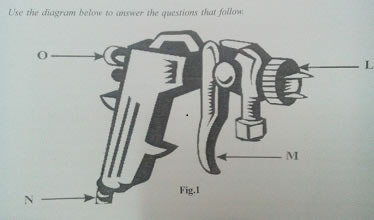Question 5
(a) Describe any three of the following decorative effects:
- rag rolling;
- broken colour;
- graining;
- blending.
- Explain the process involved in producing the three decorative effects described in 5(a) above.
Observation
The question is on decorative effects, which is practically inclined. This limited the candidates’ performance because of little or no practical experience. Notwithstanding, a few were able to answer the question. The candidates were expected to provide the following answers in order to score good marks.
(a) (i) Rag rolling: This is a method of a broken colour effect in tinted glaze
medium whereby a piece of absorbent material is rolled over a scumble to reveal part of the ground.
(ii) Broken colour: This is the use of multiple colours stippled together to form a decorative pattern.
(iii) Bleaching: This is a method of graduating the tone of a scumble from dark to a higher tone with the addition of transparent glaze and stippling brush.
(iv) Graining: This is the reproduction of the grain of any timber achieved by manipulating semi-transparent glazes over a painted ground of solid colour. (undercoat/egg shell.)
(b) (i) Process of producing rag rolling:
- prepare a solid ground surface coated with under coat or eggshell.
- apply glaze medium on the prepared solid ground surface.
- when still wet wrung a tightly twisted non-lint rag or chamois leather already dipped in spirit between the fingers.
- roll the rag over the wet glaze medium in irregular motion from bottom to top.
(ii) Process of producing broken colour:
- prepare a solid ground colour painted in undercoat or eggshell.
- apply transparent glaze on the ground colour.
- when the glaze is still wet, drop patches of colour in different shapes and size on it.
- blend together the patches with stipple brush by stippling the colours in different direction.
(iii) Process of producing graining:
- Prepare the solid ground colour coated with eggshell or undercoat.
- apply the scumble with a flat brush over solid ground colour.
- while it is still wet, use a comb to etch an open grain pattern into the colour scumble.
- draw the comb across the surface tipping and rolling it from one end to the other.
- rock the comb from side to side to produce wider patterns.
- use stippling brush to reduce comb marks.
(iv) Process of producing blending:
- prepare the solid ground colour coated with undercoat or eggshell.
- apply the scumble on any area of the surface depending on the direction of the blending work.
- add glaze in measured quantity to the scumble at various stages of the blending work and stipple until a higher tone is produced.

